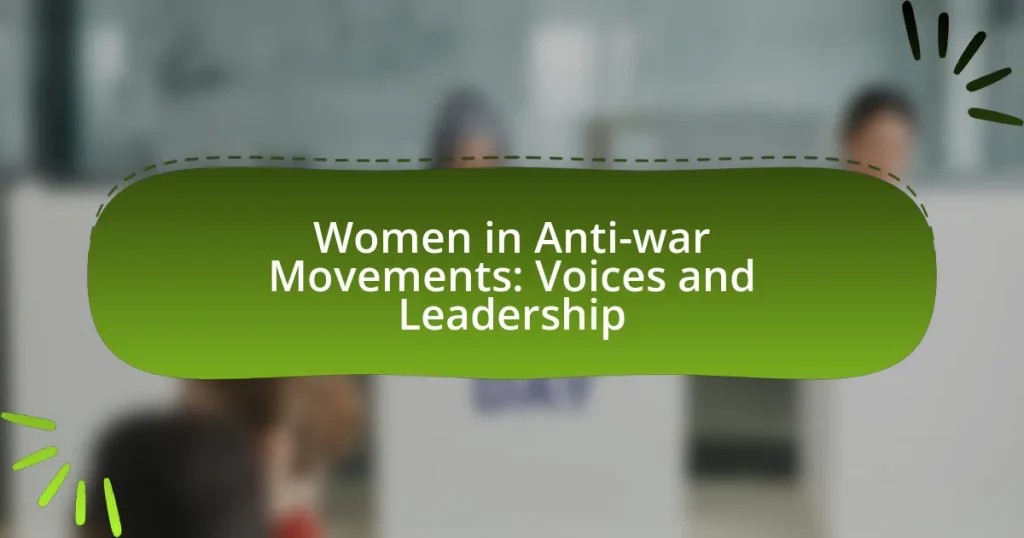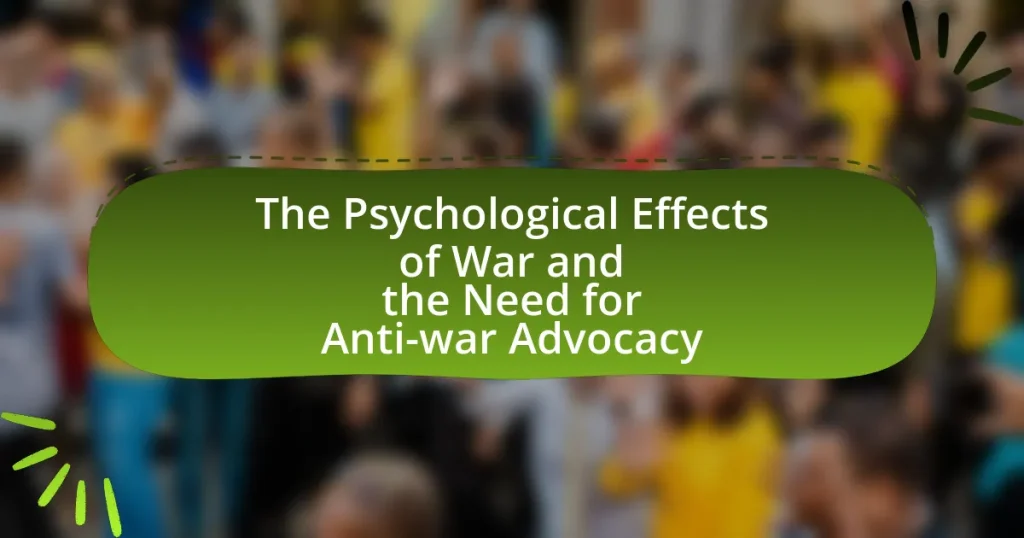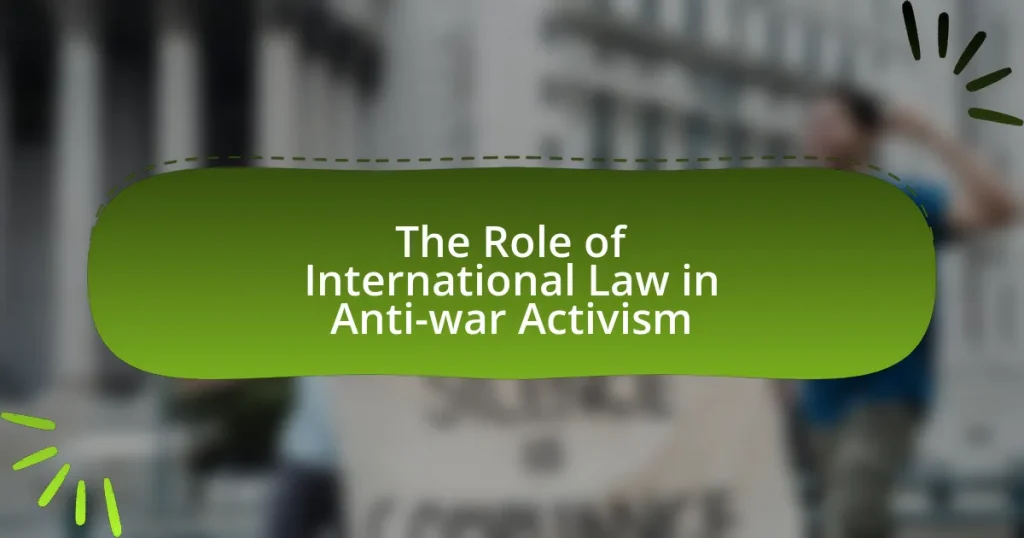Grassroots movements are organized efforts by ordinary individuals at the community level aimed at advocating for social or political change, particularly in shaping anti-war policies. These movements play a crucial role in mobilizing public opinion, raising awareness about the consequences of war, and pressuring policymakers to reconsider military actions. The article explores how grassroots movements influence public sentiment through community engagement, coalition-building, and effective communication strategies, highlighting historical examples such as the Vietnam War protests. Additionally, it addresses the challenges these movements face, including limited resources and political opposition, while outlining best practices for sustaining advocacy efforts and maintaining momentum in the pursuit of peace initiatives.
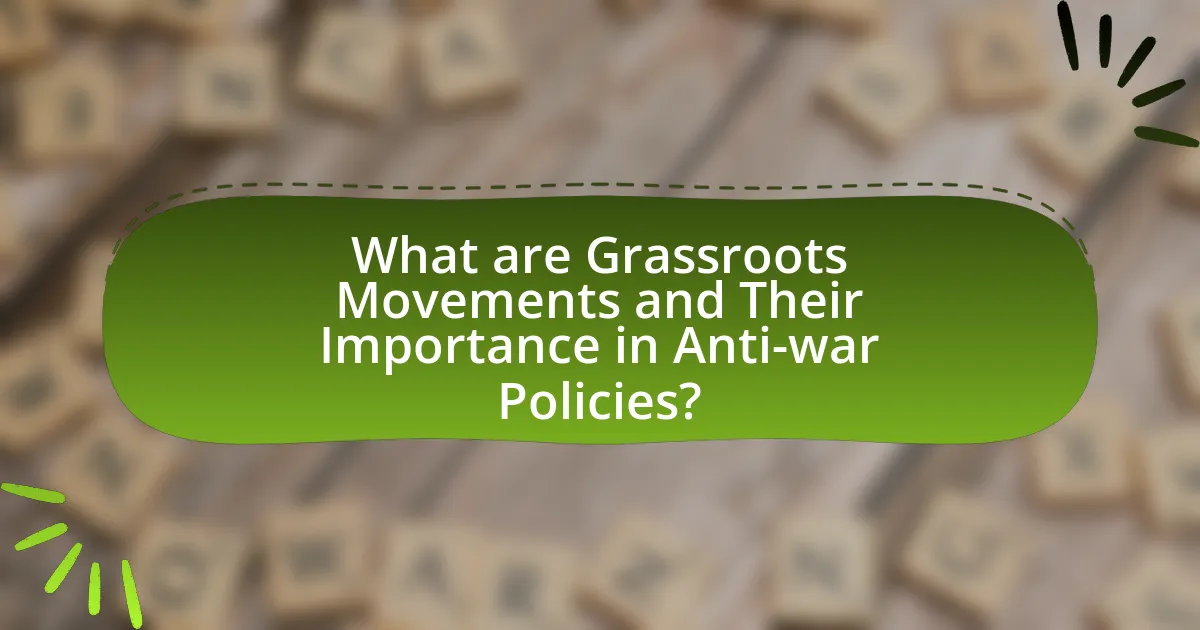
What are Grassroots Movements and Their Importance in Anti-war Policies?
Grassroots movements are organized efforts by ordinary people at the community level to advocate for social or political change, often focusing on issues like anti-war policies. These movements are crucial in shaping anti-war policies as they mobilize public opinion, raise awareness about the consequences of war, and pressure policymakers to reconsider military actions. Historical examples include the Vietnam War protests in the 1960s, where grassroots activism significantly influenced U.S. government decisions, leading to a shift in public sentiment and policy. Such movements demonstrate the power of collective action in challenging established narratives and promoting peace initiatives.
How do grassroots movements influence public opinion on war?
Grassroots movements significantly influence public opinion on war by mobilizing communities, raising awareness, and fostering dialogue. These movements often utilize social media, public demonstrations, and community organizing to disseminate information and challenge prevailing narratives about military conflicts. For instance, the Vietnam War protests in the 1960s and 1970s exemplified how grassroots activism shifted public sentiment against the war, leading to increased skepticism and opposition among the American populace. Research indicates that sustained grassroots efforts can lead to a measurable decline in public support for military interventions, as seen in various polls during the Iraq War, where anti-war sentiment grew in response to organized activism.
What strategies do grassroots movements use to mobilize support against war?
Grassroots movements mobilize support against war through community organizing, coalition building, and effective communication strategies. Community organizing involves engaging local populations to raise awareness about the consequences of war, often utilizing town hall meetings and workshops to foster dialogue. Coalition building allows these movements to unite various groups, such as veterans, peace organizations, and social justice advocates, amplifying their collective voice and resources. Effective communication strategies include leveraging social media platforms to disseminate information rapidly, share personal stories, and mobilize protests, which have been shown to increase public engagement and awareness. For instance, the anti-Vietnam War movement utilized these strategies effectively, leading to widespread protests and significant shifts in public opinion against the war.
How do grassroots movements engage with local communities to promote anti-war sentiments?
Grassroots movements engage with local communities to promote anti-war sentiments by organizing local events, facilitating discussions, and mobilizing community members for collective action. These movements often host town hall meetings, workshops, and rallies that encourage dialogue about the impacts of war, fostering a sense of community solidarity against militarism. For instance, organizations like Code Pink have effectively utilized community outreach to raise awareness about the consequences of military interventions, thereby influencing public opinion. Additionally, grassroots movements leverage social media platforms to disseminate information and connect with individuals, amplifying their message and encouraging grassroots activism. This approach has been shown to increase community participation and strengthen anti-war sentiments, as evidenced by the significant turnout at local protests and advocacy campaigns.
Why are grassroots movements essential for shaping anti-war policies?
Grassroots movements are essential for shaping anti-war policies because they mobilize public opinion and create pressure on policymakers. These movements often arise from communities directly affected by war, allowing them to articulate their experiences and demands effectively. Historical examples, such as the Vietnam War protests in the 1960s, demonstrate how grassroots activism can influence government decisions, leading to a shift in public policy. Research indicates that sustained grassroots efforts can lead to significant legislative changes, as seen in the U.S. Congress’s eventual withdrawal of support for the Vietnam War due to widespread public dissent. Thus, grassroots movements play a critical role in advocating for peace and influencing anti-war legislation.
What historical examples illustrate the impact of grassroots movements on anti-war policies?
Grassroots movements have significantly influenced anti-war policies throughout history, with notable examples including the Vietnam War protests and the Women’s Peace Movement. The Vietnam War protests, particularly in the late 1960s and early 1970s, mobilized millions of Americans who organized demonstrations, marches, and sit-ins, leading to a shift in public opinion against the war. This widespread dissent pressured the U.S. government to reconsider its military involvement, ultimately contributing to the decision to withdraw troops in 1973. Similarly, the Women’s Peace Movement, which gained momentum during the Cold War, organized events like the Women’s March for Peace in 1982, advocating for nuclear disarmament and influencing policymakers to adopt more peaceful approaches. These movements exemplify how grassroots activism can effectively challenge and reshape government policies regarding war.
How do grassroots movements challenge established political narratives regarding war?
Grassroots movements challenge established political narratives regarding war by mobilizing public opinion and fostering alternative perspectives that question the justifications for military action. These movements often utilize social media, community organizing, and public demonstrations to raise awareness about the human, economic, and ethical costs of war, thereby countering dominant narratives that portray military intervention as necessary or beneficial. For instance, the anti-Vietnam War movement in the 1960s effectively shifted public sentiment against U.S. involvement by highlighting civilian casualties and the war’s impact on American soldiers, leading to a significant change in policy and public discourse. This historical example illustrates how grassroots activism can disrupt prevailing narratives and influence political decision-making.
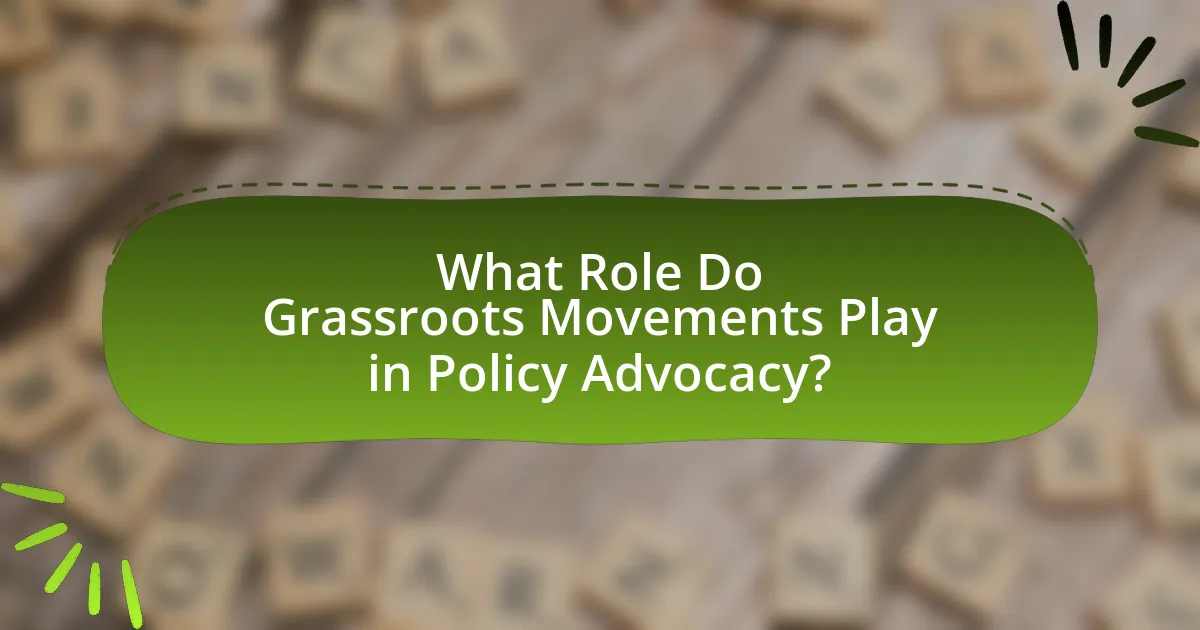
What Role Do Grassroots Movements Play in Policy Advocacy?
Grassroots movements play a crucial role in policy advocacy by mobilizing community members to influence decision-makers and shape public policy. These movements often raise awareness about specific issues, such as anti-war sentiments, by organizing protests, campaigns, and educational initiatives that highlight the consequences of war. For instance, the Vietnam War protests in the 1960s exemplified how grassroots activism can sway public opinion and ultimately lead to policy changes, as significant public pressure contributed to the U.S. government’s decision to withdraw troops. Additionally, grassroots movements utilize social media and digital platforms to amplify their messages, engage a broader audience, and foster collective action, thereby enhancing their impact on policy advocacy.
How do grassroots movements collaborate with other organizations to influence policy?
Grassroots movements collaborate with other organizations to influence policy by forming coalitions that amplify their collective voice and resources. These collaborations often involve strategic partnerships with non-profits, advocacy groups, and community organizations, allowing grassroots movements to leverage shared goals and expertise. For example, the anti-war movement in the United States during the Vietnam War era saw grassroots organizations partner with established civil rights groups to mobilize larger protests and campaigns, effectively increasing public awareness and pressure on policymakers. This synergy enhances their ability to engage in lobbying efforts, organize events, and disseminate information, ultimately leading to more significant policy impact.
What types of coalitions are formed between grassroots movements and larger organizations?
Grassroots movements form several types of coalitions with larger organizations, primarily including strategic alliances, formal partnerships, and issue-based coalitions. Strategic alliances occur when grassroots movements and larger organizations collaborate to achieve common goals, leveraging each other’s strengths for greater impact. Formal partnerships often involve contractual agreements that outline shared responsibilities and resources, enhancing the capacity of grassroots movements to influence policy. Issue-based coalitions focus on specific topics, such as anti-war initiatives, where both grassroots and larger organizations unite to amplify their voices and mobilize resources effectively. These coalitions are essential in shaping anti-war policies, as they combine grassroots activism with the institutional power of larger organizations, leading to more significant advocacy efforts and public engagement.
How do these collaborations enhance the effectiveness of anti-war advocacy?
Collaborations among grassroots movements enhance the effectiveness of anti-war advocacy by pooling resources, amplifying voices, and creating a unified message. When diverse organizations work together, they can reach a broader audience, as seen in the 2003 global protests against the Iraq War, where millions participated across various countries, demonstrating widespread opposition. This collective action not only raises awareness but also exerts pressure on policymakers, as evidenced by the significant decline in public support for the war following these coordinated efforts. Additionally, collaborations allow for the sharing of strategies and best practices, increasing the overall impact of advocacy campaigns.
What tactics do grassroots movements employ to lobby for anti-war policies?
Grassroots movements employ tactics such as organizing protests, mobilizing community outreach, and leveraging social media to lobby for anti-war policies. These tactics enable grassroots organizations to raise public awareness, build coalitions, and influence policymakers. For instance, large-scale demonstrations, like the 2003 anti-Iraq War protests, mobilized millions globally, showcasing public dissent and pressuring governments to reconsider military actions. Additionally, grassroots movements often engage in direct lobbying efforts, where activists meet with legislators to advocate for specific policy changes, supported by research and public opinion data that highlight the negative impacts of war.
How do grassroots movements utilize social media to amplify their message?
Grassroots movements utilize social media to amplify their message by leveraging platforms to reach a wider audience quickly and effectively. These movements create shareable content, such as videos, infographics, and posts, that resonate with users, encouraging them to engage and share further. For instance, the #NoWar hashtag campaigns have mobilized thousands, demonstrating the power of social media in organizing protests and spreading awareness. Research indicates that social media can increase engagement by up to 60%, allowing grassroots movements to connect with supporters globally and influence public opinion on anti-war policies.
What role do protests and demonstrations play in grassroots advocacy for anti-war policies?
Protests and demonstrations serve as critical tools in grassroots advocacy for anti-war policies by mobilizing public opinion and influencing policymakers. These collective actions create visible expressions of dissent, which can attract media attention and raise awareness about the consequences of war. Historical examples, such as the Vietnam War protests in the 1960s, illustrate how large-scale demonstrations galvanized public sentiment against military engagement, ultimately contributing to shifts in government policy. Additionally, research indicates that sustained grassroots movements, characterized by protests, can lead to significant political change, as seen in the anti-nuclear movement of the 1980s, which successfully pressured governments to reconsider their military strategies.
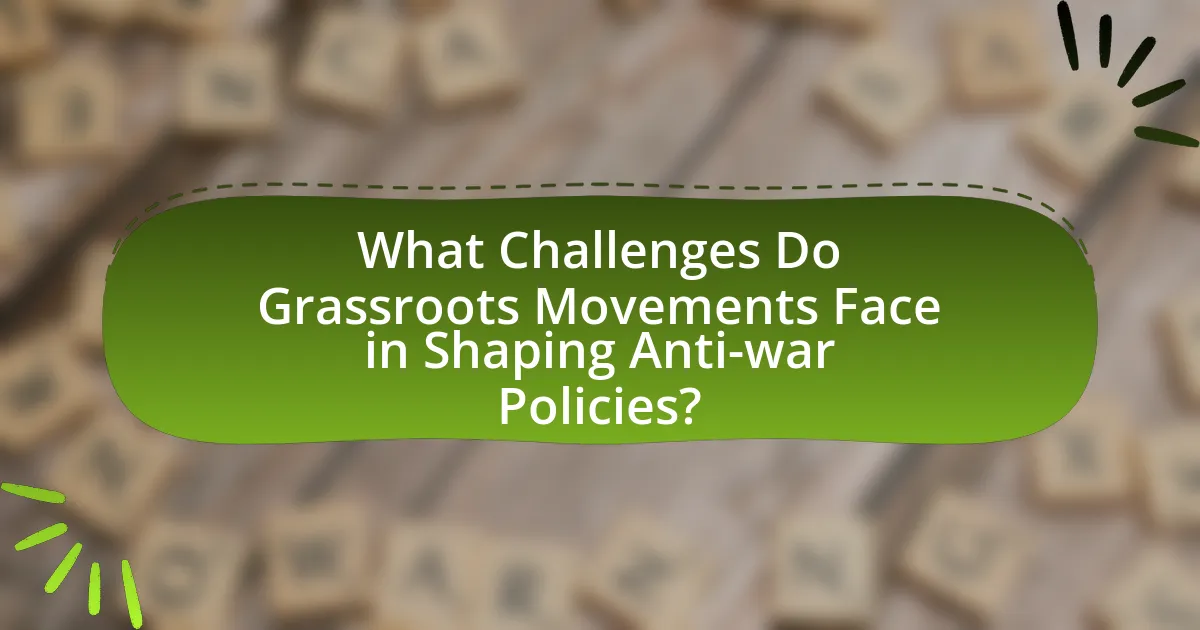
What Challenges Do Grassroots Movements Face in Shaping Anti-war Policies?
Grassroots movements face significant challenges in shaping anti-war policies, primarily due to limited resources and political influence. These movements often operate with minimal funding and rely on volunteer efforts, which restricts their ability to mobilize large-scale campaigns or conduct extensive outreach. Additionally, grassroots movements frequently encounter resistance from established political entities and media, which may downplay their messages or portray them negatively. For instance, during the Vietnam War, organizations like the Students for a Democratic Society struggled to gain traction against the dominant narratives promoted by the government and mainstream media. Furthermore, the fragmentation within grassroots movements can lead to a lack of unified strategy, making it difficult to present a coherent stance on anti-war policies. This disunity can dilute their impact and hinder their ability to influence policymakers effectively.
What obstacles do grassroots movements encounter in their advocacy efforts?
Grassroots movements encounter several obstacles in their advocacy efforts, including limited funding, lack of media coverage, and opposition from established political entities. Limited funding restricts their ability to organize events, conduct outreach, and sustain long-term campaigns, as evidenced by a study from the National Committee for Responsive Philanthropy, which found that grassroots organizations receive only a small fraction of total philanthropic funding. Lack of media coverage diminishes their visibility and public support, making it difficult to amplify their messages; for instance, research by the Pew Research Center indicates that mainstream media often prioritizes larger organizations over grassroots initiatives. Additionally, established political entities may actively oppose grassroots movements, employing tactics such as lobbying and misinformation to undermine their efforts, as seen in various historical contexts where grassroots anti-war movements faced significant pushback from government and military interests.
How do funding and resource limitations affect grassroots movements?
Funding and resource limitations significantly hinder grassroots movements by restricting their ability to mobilize, organize, and sustain campaigns. Without adequate financial support, these movements struggle to cover essential costs such as outreach, materials, and event logistics, which are crucial for raising awareness and engaging the community. For instance, a study by the National Committee for Responsive Philanthropy found that grassroots organizations with limited funding often face challenges in reaching broader audiences, resulting in diminished impact and effectiveness in influencing policy changes. Additionally, resource constraints can lead to burnout among volunteers and activists, further weakening the movement’s capacity to advocate for anti-war policies effectively.
What strategies do grassroots movements use to overcome these challenges?
Grassroots movements employ various strategies to overcome challenges in shaping anti-war policies, including coalition-building, grassroots mobilization, and leveraging social media for awareness. Coalition-building allows these movements to unite diverse groups, enhancing their collective power and resources, as seen in the 2003 anti-Iraq War protests where various organizations collaborated to amplify their message. Grassroots mobilization involves organizing local events and demonstrations to engage community members directly, which was effective in the Vietnam War era when local protests significantly influenced public opinion. Additionally, leveraging social media enables grassroots movements to disseminate information rapidly, mobilize supporters, and create viral campaigns, exemplified by the #NoWar hashtag that gained traction during recent conflicts. These strategies collectively enhance the visibility and impact of grassroots movements in advocating for anti-war policies.
How do grassroots movements navigate political opposition to anti-war policies?
Grassroots movements navigate political opposition to anti-war policies by mobilizing community support, leveraging social media, and forming coalitions with like-minded organizations. These movements often engage in grassroots organizing, which includes door-to-door canvassing, public demonstrations, and educational campaigns to raise awareness about the consequences of war. For instance, during the Vietnam War, organizations like Students for a Democratic Society effectively utilized protests and sit-ins to challenge government policies, demonstrating the power of collective action. Additionally, grassroots movements often utilize social media platforms to amplify their message, reach a broader audience, and counteract political narratives that support war. Research shows that social media campaigns can significantly influence public opinion, as seen in the anti-Iraq War protests in the early 2000s, where online mobilization played a crucial role in gathering support. By building coalitions with other advocacy groups, grassroots movements can strengthen their influence and present a united front against political opposition, thereby increasing their chances of effecting change in anti-war policies.
What methods are effective in countering misinformation about anti-war movements?
Effective methods for countering misinformation about anti-war movements include fact-checking, promoting media literacy, and leveraging social media platforms for accurate information dissemination. Fact-checking organizations, such as Snopes and FactCheck.org, actively debunk false claims related to anti-war narratives, providing evidence-based corrections. Promoting media literacy equips individuals with skills to critically evaluate sources and discern credible information from misinformation. Additionally, social media platforms can be utilized to share verified information and counter false narratives, as seen in campaigns by organizations like MoveOn, which mobilize grassroots support to amplify accurate messaging. These methods collectively enhance public understanding and reduce the spread of misinformation regarding anti-war movements.
How can grassroots movements maintain momentum in the face of political resistance?
Grassroots movements can maintain momentum in the face of political resistance by fostering strong community engagement and utilizing strategic communication. Engaging local communities through regular meetings, outreach programs, and collaborative events builds a sense of ownership and commitment among participants, which is crucial for sustaining energy and focus. Additionally, effective communication strategies, such as leveraging social media platforms and traditional media, help to amplify their message and mobilize support, even in challenging political climates. Historical examples, such as the Civil Rights Movement, demonstrate that sustained grassroots efforts can lead to significant policy changes despite initial resistance, as seen in the eventual passage of the Civil Rights Act of 1964.
What Best Practices Can Grassroots Movements Adopt for Effective Advocacy?
Grassroots movements can adopt several best practices for effective advocacy, including building a strong community base, utilizing social media for outreach, and forming coalitions with like-minded organizations. A strong community base fosters trust and mobilizes individuals around a common cause, which is essential for sustained advocacy efforts. Utilizing social media allows grassroots movements to reach a wider audience quickly and efficiently, as evidenced by the success of campaigns like the Arab Spring, where social media played a crucial role in organizing protests. Forming coalitions enhances resource sharing and amplifies voices, as seen in the Women’s March, which united various groups to advocate for women’s rights and social justice. These practices collectively enhance the effectiveness of grassroots advocacy in shaping policies, particularly in anti-war contexts.
How can grassroots movements build sustainable networks for ongoing advocacy?
Grassroots movements can build sustainable networks for ongoing advocacy by fostering strong community engagement and leveraging digital platforms for communication. Engaging local communities through regular meetings, workshops, and outreach initiatives creates a sense of ownership and commitment among participants. Additionally, utilizing social media and online tools allows these movements to reach a broader audience, share resources, and coordinate efforts effectively. For instance, the Women’s March in 2017 utilized social media to mobilize millions globally, demonstrating the power of digital networks in sustaining advocacy efforts. By combining local engagement with digital outreach, grassroots movements can create resilient networks that persist over time.
What lessons can be learned from successful grassroots movements in history?
Successful grassroots movements in history demonstrate the importance of community engagement, strategic messaging, and coalition-building. For instance, the Civil Rights Movement in the United States effectively mobilized local communities to advocate for systemic change, leading to significant legislative outcomes like the Civil Rights Act of 1964. This movement showcased how grassroots organizing can amplify voices and create pressure for policy reform. Additionally, the anti-Vietnam War protests of the 1960s illustrated the power of sustained public demonstrations and media engagement in shifting public opinion and influencing government decisions. These examples highlight that grassroots movements can achieve meaningful change by fostering solidarity, utilizing effective communication strategies, and maintaining persistence in their efforts.

